
The past year has been a great eye-opener for me as far as finding new places to ride in an area I thought I'd exhausted. In particular, I've been impressed by local randonneuse Pamela Blalock's ability to design routes entirely along back roads, with minimal motorised traffic. This style of route involves more climbing than typical, and, at times, some intense navigation. But having gotten used to both, I've come to appreciate the opportunities routes like this provide: to travel on my bike largely undisturbed by cars, and to truly get to know an area, with all its hidden scenery and useful shortcuts.I also appreciate that Pamela's routes are not a matter of luck or psychic powers, but of dedicated research and strategic exploring.

Until recently I did not feel sufficiently confident in my navigation skills to try this myself, butnow that is changing. I am planning a ride heading North, and getting out of Boston straight up the coast is a thoroughly unpleasant business. There is no good way to do it; for the first 10 miles it is all dangerous roads and lots of congestion. So I wanted to plan a route that would swing out west and come around from there, connecting to the northern route at a point where it calms down. This adds about 30 extra miles to the start of the trip, but I will take 40 pleasant miles over 10 unpleasant ones any time.
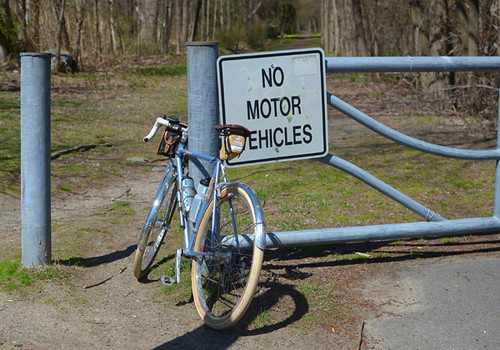
In planning the westward route extension, my goal was to try and do it along lightly traveled back roads, possibly with some unpaved stretches. I started by studying similar routes that go through the area, combining and modifying them based on personal experience, maps, and educated guesswork, until I'd strung something together that went where I needed it to go. I loaded the route onto GPS, printed out a cue sheet, and got on my bike to test out my handiwork.

For my first time trying something like this, it wasn't bad. There were lots of turns that would drive some people nuts and a few awkward climbs - the kind where a climb starts right after a sharp turn, catching you by surprise, so that you're downshifting madly from a high gear. This I didn't mind, particularly since I was the only vehicle on the road much of the time. But there was also a couple of mistakes/ surprises - not necessarily bad, but educational.

My route included a few unpaved trails, all except one of which I was already familiar with. The one I was not familiar with turned out to be more technical than I'd expected.
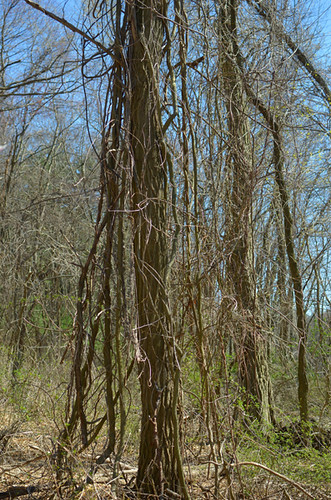
A shortcut through the woods, the narrow bumpy trail wound its way downhill between trees rather tightly. I was able to ride it, but made a note to avoid it on skinny tires, in wet weather and in the dark. Looking at the map, I saw there was a way to circumvent the woods on the road, so I then went back and tested that stretch to make sure it was a sufficiently traffic-free alternative.
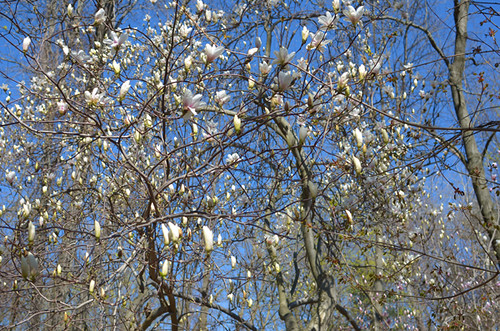
While not ideal for all bikes and all occasions, this trail proved to be incredibly scenic this time of year. For much of it, I cycled under a canopy of budding magnolia blossoms.The sun brought out their colours against the blue sky, and the warm weather brought out their scent.

Riding here, I felt as if I'd been gifted a rare glimpse into something special and rare. Only for 2 weeks of the year do these flowers blossom. And all it takes is one windy, rainy day, for all this tentative pinkness to be stripped off its branches before the flowers even fully open up.

Spring is such a delicate time of the year. The greens are pale, the tangled trees are transparent like lace. In the summer this will all become fuller, heavier, thicker - a dense fabric.

Even moss is paler and softer. I love coming back to the woods season after season and seeing it all change.
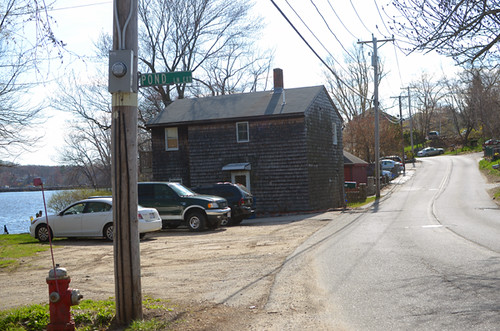
Further along, I found myself on a stretch of road that was much busier than expected. So I changed course in hopes of finding a better alternative. On the map I saw a tangle of side streets that it looked like I could ride through to get to my next point, skipping the busy road. So I did just that, and found myself in a cul-de-sac neighbourhood situated on a substantial hill. Looking for the best route, I ended up going over this hill several times from different directions, until I found the sequence I was happiest with.
On one of the streets I passed a group of small boys with their kids' bikes. The poor things could only ride them up and down short stretches in front of their house before the road became too steep. Seeing me continue all the way up the hill, the boys stopped what they were doing, stood still and stared, saying "Whoa, I want to do that!" and "That's a nice bike, lady!" They had not reached that age yet where youthful mockery becomes hard to detect; it was clear their delight was genuine.
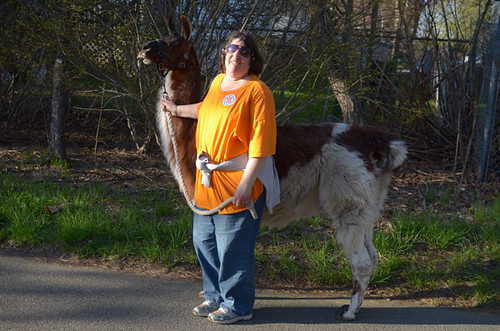
Later, I encountered a woman walking a llama, as casually as if she were walking a dog. Normally I am not good at making quick u-turns, but this time it was no problem (llama!).

Heading home along a quiet trail, I realised that in the course of the past 50 miles there had only been a few stretches with noticeable car traffic. And now that I had a better understanding of the neighbourhoods around those stretches, I could make changes to improve those parts as well. It wasn't perfect, but I am pretty happy with my first serious attempt at backroad route planning. Even the parts that did not go as expected allowed me to explore and discover interesting pockets I would have otherwise missed.
Having a network of new, "secret" as some locals refer to them, routes through familiar areas is extremely exciting and a great way to travel. I am looking forward to doing more of this!

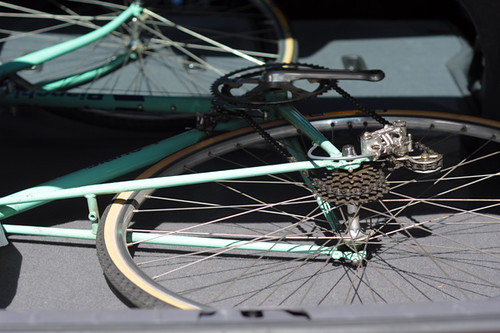 Earlier this month, I parted with my remaining vintage roadbikes: a 1982 Bianchi and a 1978Francesco Moser. Both bicycles ended up going to people I know, and their futures look promising. The Moser will be built up as a geared roadbike again and ridden by a long-time local cyclist.TheBianchiwill get a make-over and may end up riding in theEroica. The bikes moved on to greener pastures, leaving me with only my Rivendell to contemplate lessons learned and a direction for the future.
Earlier this month, I parted with my remaining vintage roadbikes: a 1982 Bianchi and a 1978Francesco Moser. Both bicycles ended up going to people I know, and their futures look promising. The Moser will be built up as a geared roadbike again and ridden by a long-time local cyclist.TheBianchiwill get a make-over and may end up riding in theEroica. The bikes moved on to greener pastures, leaving me with only my Rivendell to contemplate lessons learned and a direction for the future.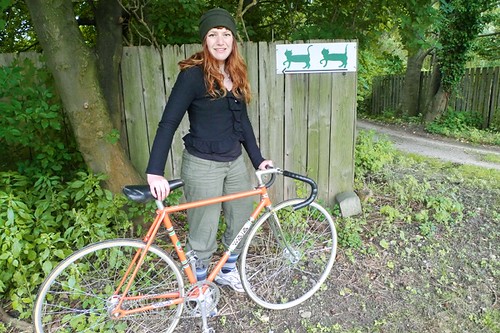 I've been experimenting with vintage roadbikes since last summer, which has included riding other people's bikes and also buying a few for the express purpose of playing around with them. The bicycles I've tried in this manner have included examples of American, French, Japanese, English and Italian bikes from the late 1970s and early '80s. Not an enormous sample, but a nice beginner's crash course. Somewhat to my surprise, I found that I liked every Italian bicycle I tried, whereas the mid-tier French bicycles felt the worst. The Japanese bikes were comfortable, and I could see the roots of Rivendell's philosophy in their geometry and handling. It was very interesting - but ultimately unsustainable.
I've been experimenting with vintage roadbikes since last summer, which has included riding other people's bikes and also buying a few for the express purpose of playing around with them. The bicycles I've tried in this manner have included examples of American, French, Japanese, English and Italian bikes from the late 1970s and early '80s. Not an enormous sample, but a nice beginner's crash course. Somewhat to my surprise, I found that I liked every Italian bicycle I tried, whereas the mid-tier French bicycles felt the worst. The Japanese bikes were comfortable, and I could see the roots of Rivendell's philosophy in their geometry and handling. It was very interesting - but ultimately unsustainable. For one thing, even if a vintage bike is in good condition, it takes me a great deal of resources to set it up in a way I find ridable: Usually I have to change the brake levers, the handlebars, and - if I want to comfortably switch gears - the shifters. Not only does this require time and money, but it also ultimately changes the bike's character.
For one thing, even if a vintage bike is in good condition, it takes me a great deal of resources to set it up in a way I find ridable: Usually I have to change the brake levers, the handlebars, and - if I want to comfortably switch gears - the shifters. Not only does this require time and money, but it also ultimately changes the bike's character.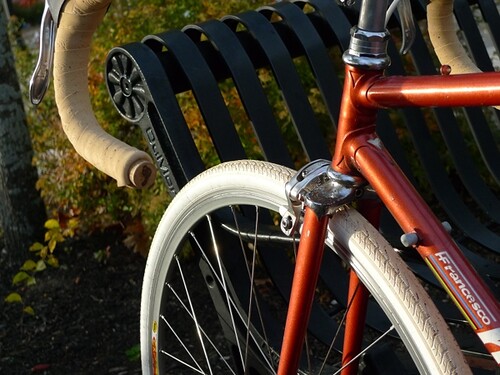 Considering the kind of cycling I have been gravitating toward, I would ultimately like to have three roadbikes: a fully equipped touring bike that is capable of going off road, a fixed gear bike,and a "racy" bike that is suitable for competitive cycling. The first I already have. The second I am finally working onafter a year of riding a conversion. And the third will be my next priority. I feel guilty that I don't see vintage in the equation, but practical needs trump aesthetic and historical interest. When I am older and have more time and money, I would love to collect gorgeous, historically significant vintage frames. But for now I would like to ride more, tinker less.
Considering the kind of cycling I have been gravitating toward, I would ultimately like to have three roadbikes: a fully equipped touring bike that is capable of going off road, a fixed gear bike,and a "racy" bike that is suitable for competitive cycling. The first I already have. The second I am finally working onafter a year of riding a conversion. And the third will be my next priority. I feel guilty that I don't see vintage in the equation, but practical needs trump aesthetic and historical interest. When I am older and have more time and money, I would love to collect gorgeous, historically significant vintage frames. But for now I would like to ride more, tinker less.
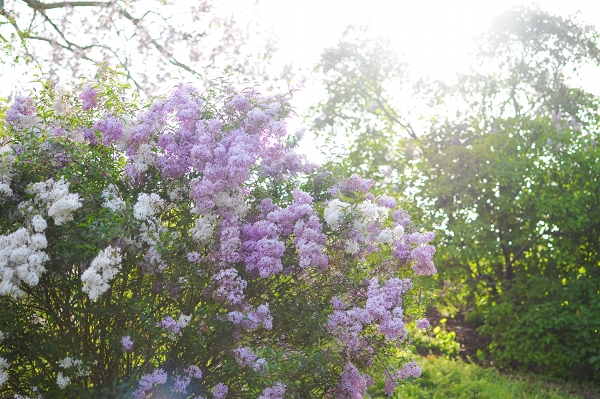 "Lilac Sunday" at the
"Lilac Sunday" at the 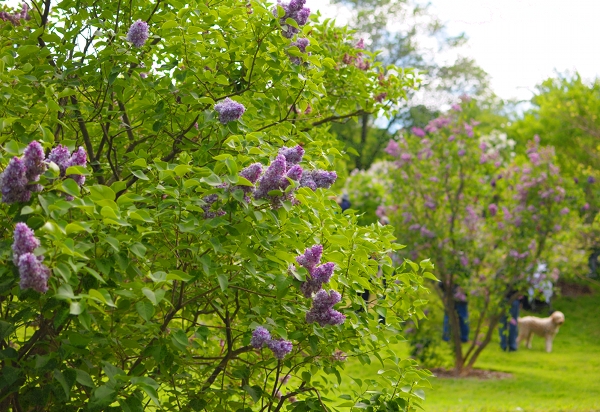 I had never been to a flower festival before and did not know what to expect. The Arboretum's "lilac collection" is basically a small hill covered with dozens of lilac plants of every variety imaginable.
I had never been to a flower festival before and did not know what to expect. The Arboretum's "lilac collection" is basically a small hill covered with dozens of lilac plants of every variety imaginable.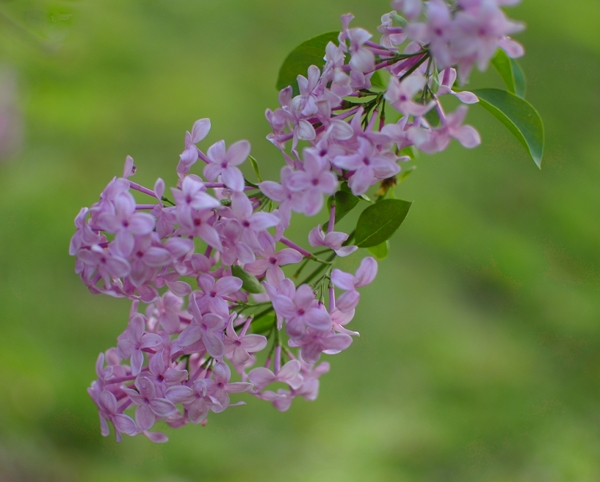 The lilacs' colours included everything from classic pale purple, to white, to ink-blue, to cherry-blossom pink.
The lilacs' colours included everything from classic pale purple, to white, to ink-blue, to cherry-blossom pink. The form of the flowers can vary quite a bit as well - from sparse, crisply outlined petals to fluffy, soft clusters.
The form of the flowers can vary quite a bit as well - from sparse, crisply outlined petals to fluffy, soft clusters. Hundreds of people at a time wandered up and down the hill to pay homage to the lilacs - smelling them, photographing them, having picnics beneath them.
Hundreds of people at a time wandered up and down the hill to pay homage to the lilacs - smelling them, photographing them, having picnics beneath them.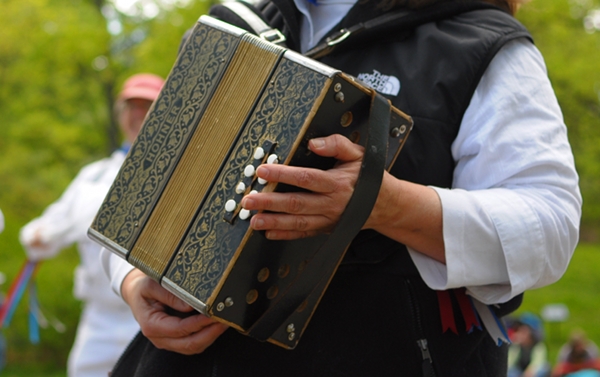 There were also musical and dance performances from several local folk groups.
There were also musical and dance performances from several local folk groups.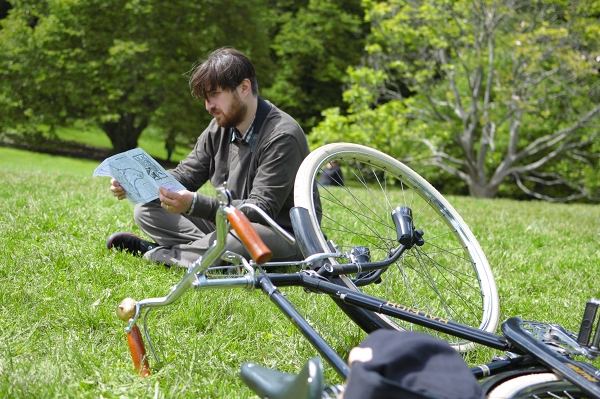 The festival was so well-attended, that there were probably more people than lilacs - but we did find a spot on the grass nearby.
The festival was so well-attended, that there were probably more people than lilacs - but we did find a spot on the grass nearby. Did I mention I love lilacs? It was blissful to see so many in one place.
Did I mention I love lilacs? It was blissful to see so many in one place.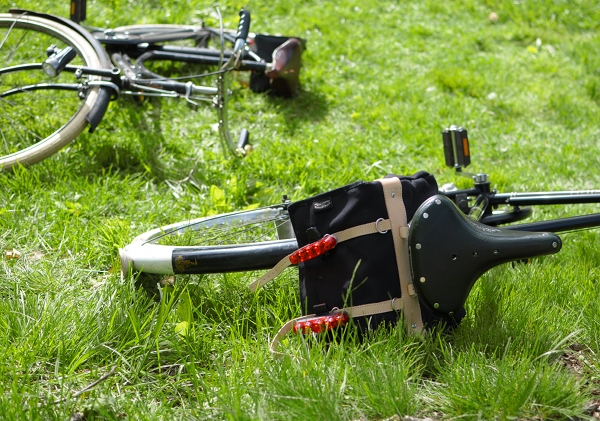 The Roadsters were happy as well, especially as they finally got to cycle along Boston's
The Roadsters were happy as well, especially as they finally got to cycle along Boston's 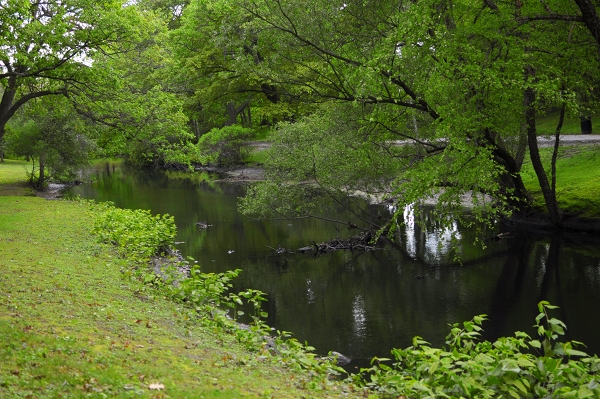 The
The 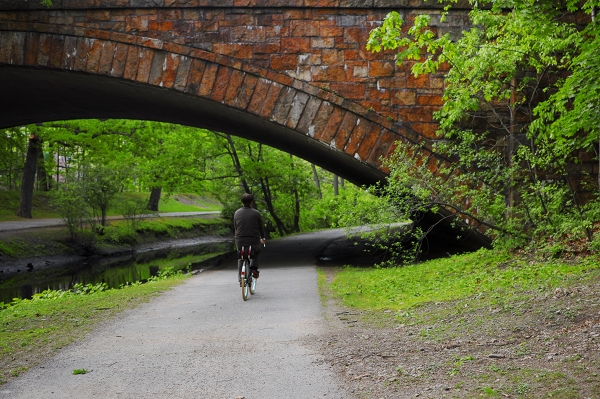 We had wanted to cycle along the entire
We had wanted to cycle along the entire  As an urban green sanctuary, the
As an urban green sanctuary, the  An additional issue, is that unless you already know how to navigate the
An additional issue, is that unless you already know how to navigate the 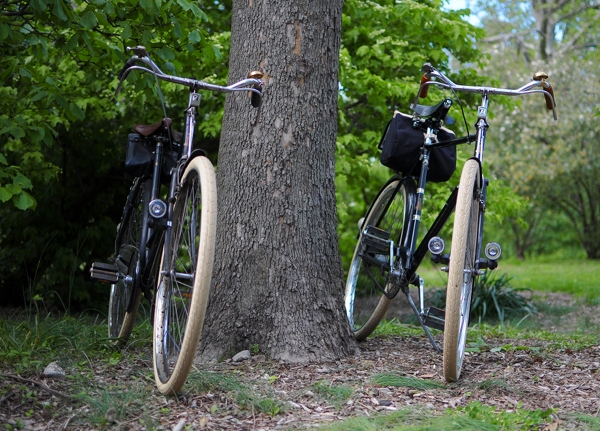 On the way back finding our way got a bit easier and we even discovered some secluded dirt paths that the Roadsters liked better than the paved trails.
On the way back finding our way got a bit easier and we even discovered some secluded dirt paths that the Roadsters liked better than the paved trails.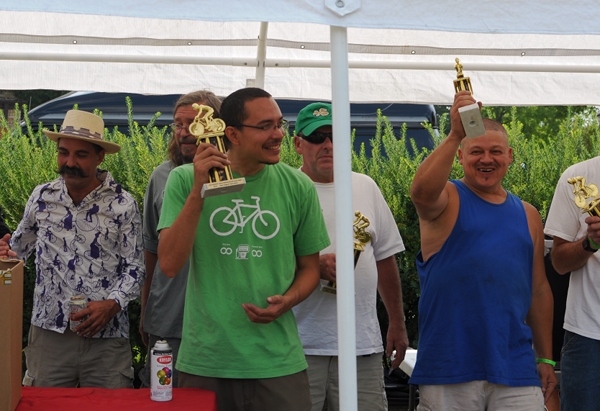 I intended to take documentary-style photographs of the show... But that did not work out so well, as it was just too crowded with too much going on! Nonetheless, here are some shots of bicycles that I especially enjoyed and you might too.
I intended to take documentary-style photographs of the show... But that did not work out so well, as it was just too crowded with too much going on! Nonetheless, here are some shots of bicycles that I especially enjoyed and you might too. Having seen pictures from previous years, I expected the Larz Anderson show to be full of antique roadster-style bicycle, but this year there were only a few. This one is an Elgin loop frame.
Having seen pictures from previous years, I expected the Larz Anderson show to be full of antique roadster-style bicycle, but this year there were only a few. This one is an Elgin loop frame. Wooden fenders, wooden chainguard and netted dressguards on another loop frame!
Wooden fenders, wooden chainguard and netted dressguards on another loop frame! And dramatic upside-down North Road handlebars (or are they track dropbars? a hybrid of the two?) on a Sterling roadster.
And dramatic upside-down North Road handlebars (or are they track dropbars? a hybrid of the two?) on a Sterling roadster.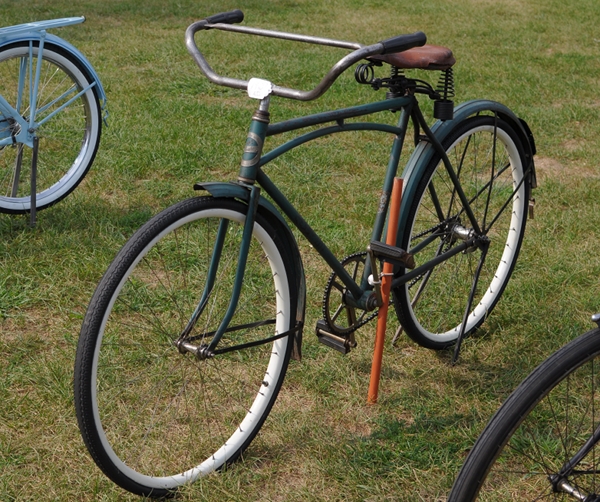 A Columbia truss bridge bicycle!
A Columbia truss bridge bicycle! I examined it up close, and it is definitely welded, not lugged - though I am not sure whether this was true of all early truss frames.
I examined it up close, and it is definitely welded, not lugged - though I am not sure whether this was true of all early truss frames.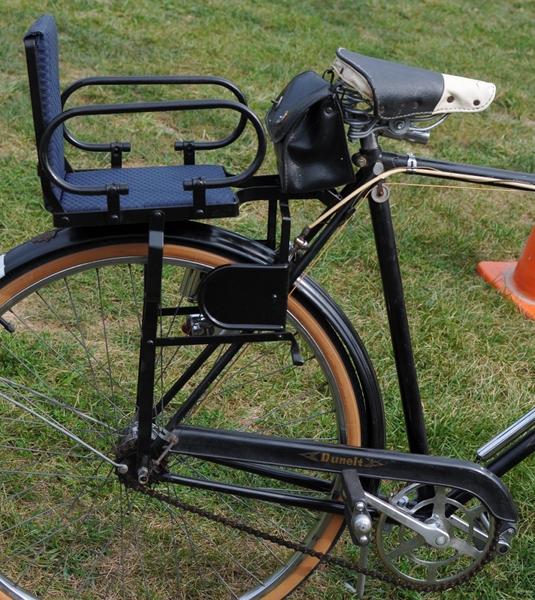 A Dunelt Roadster with baby chariot. These look so much nicer than the modern Co-Pilots! But are they road legal?
A Dunelt Roadster with baby chariot. These look so much nicer than the modern Co-Pilots! But are they road legal?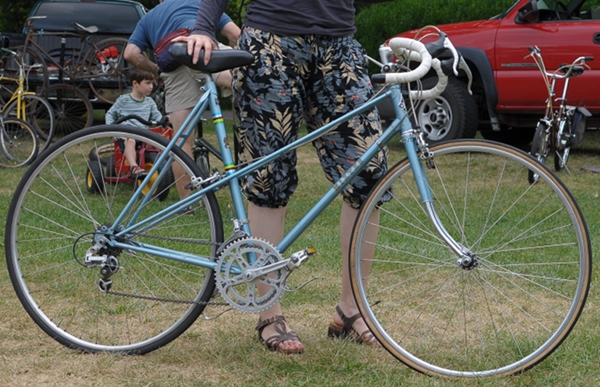 An unusual Concord mixte in a beautiful shade of slate blue.
An unusual Concord mixte in a beautiful shade of slate blue. The lugwork on this one was gorgeous and it was in exactly my size. What strength of will I have!
The lugwork on this one was gorgeous and it was in exactly my size. What strength of will I have!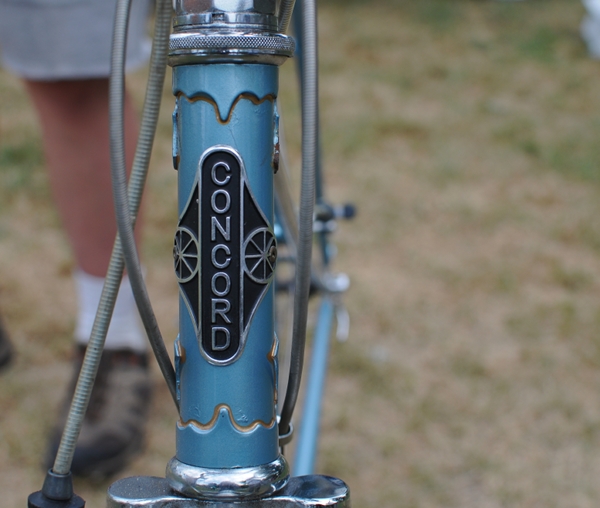 I was told that Concord was a Dutch manufacturer [edited to add: looked it up on bikeforums, and it is actually Japanese].
I was told that Concord was a Dutch manufacturer [edited to add: looked it up on bikeforums, and it is actually Japanese].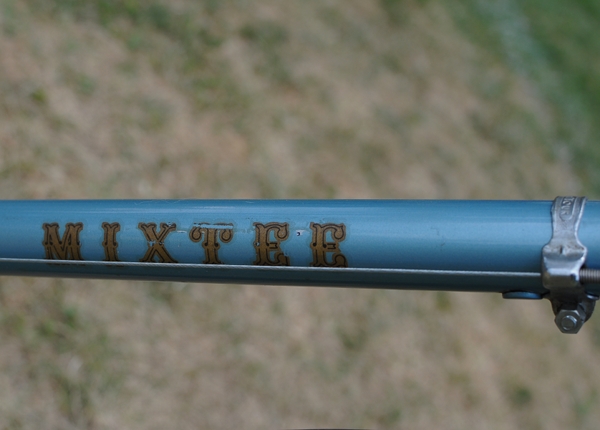 Could that explain the atypical spelling of "mixte"?
Could that explain the atypical spelling of "mixte"?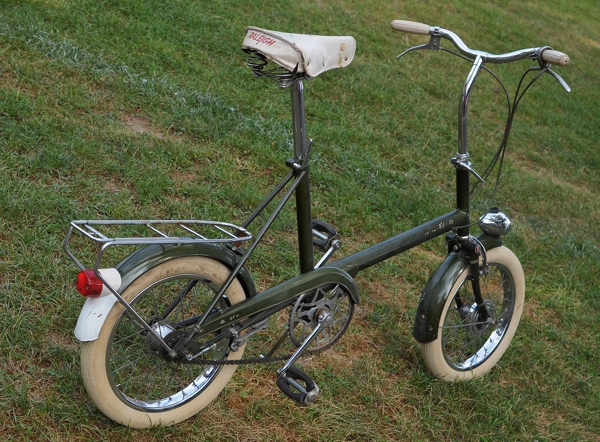 And how about this fully equippedRaleigh Sixteen? - a folding bicycle like the Raleigh Twenty, only with 16" wheels.
And how about this fully equippedRaleigh Sixteen? - a folding bicycle like the Raleigh Twenty, only with 16" wheels.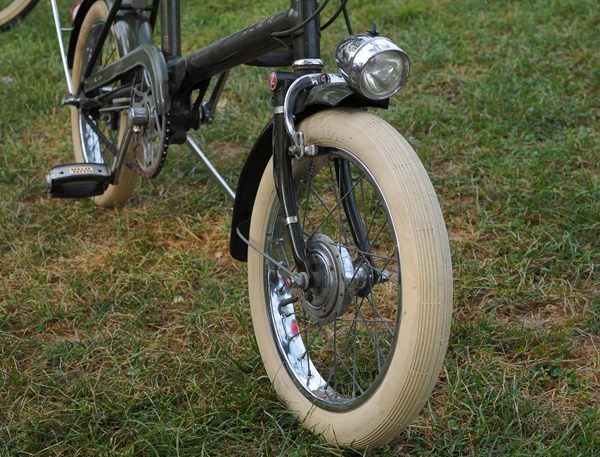 Green frame, fat cream tires and dynamo lighting! I am envious of who ever ended up taking this beauty home!
Green frame, fat cream tires and dynamo lighting! I am envious of who ever ended up taking this beauty home! The star of the show was this enormous, forest green, originalDursley Pedersen bicycle.
The star of the show was this enormous, forest green, originalDursley Pedersen bicycle.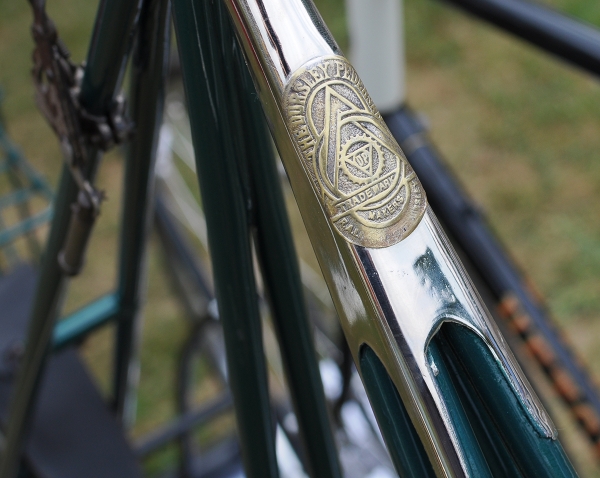 Dursley Pedersenheadbadge.
Dursley Pedersenheadbadge. Crocheted saddle (or seat in this case?).
Crocheted saddle (or seat in this case?).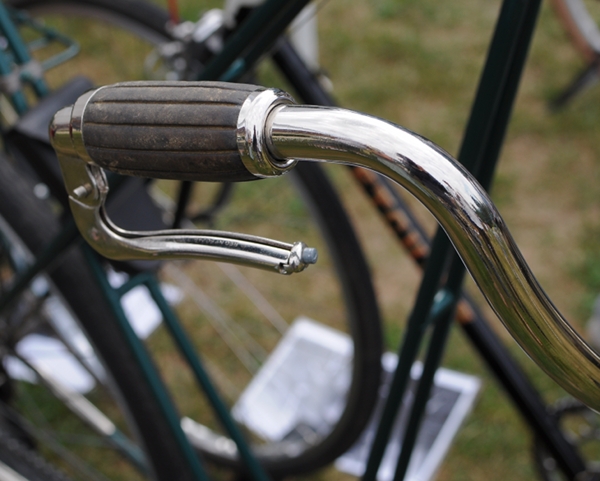 Wooden grips with inverse brake levers.
Wooden grips with inverse brake levers. And, of course, an antique headlamp! This bicycle was truly a spectacular sight.
And, of course, an antique headlamp! This bicycle was truly a spectacular sight.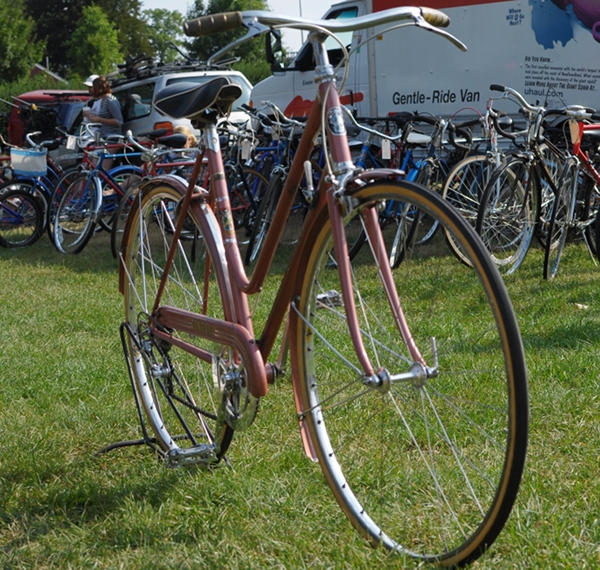 My personal favourite in the show, however, was this stunning bicycle from the 1960s, which belonged to the wife of Cino Cinelli. To my dismay, I was not able to get any good full-size pictures that capture its glamour to the extent it deserves, but maybe some hint of it will come across here!
My personal favourite in the show, however, was this stunning bicycle from the 1960s, which belonged to the wife of Cino Cinelli. To my dismay, I was not able to get any good full-size pictures that capture its glamour to the extent it deserves, but maybe some hint of it will come across here!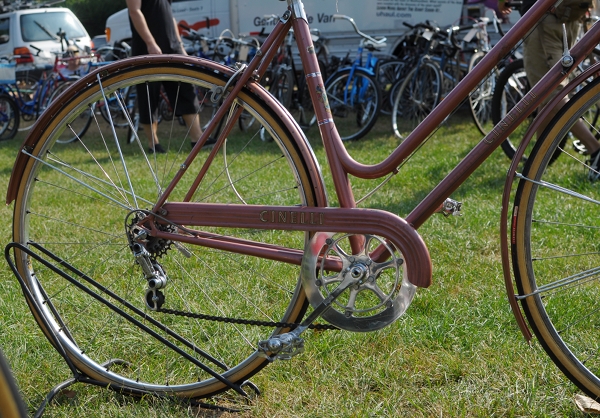 Ever seen a step-through Cinelli before? This one was apparently Mrs. Cinelli's personal ride, and it is exquisitely made. I am wondering what is the history of this particular style of frame; is it specifically Italian? I have been admiring similar designs from Abici and Bella Ciao, and would love to learn about their vintage origins.
Ever seen a step-through Cinelli before? This one was apparently Mrs. Cinelli's personal ride, and it is exquisitely made. I am wondering what is the history of this particular style of frame; is it specifically Italian? I have been admiring similar designs from Abici and Bella Ciao, and would love to learn about their vintage origins.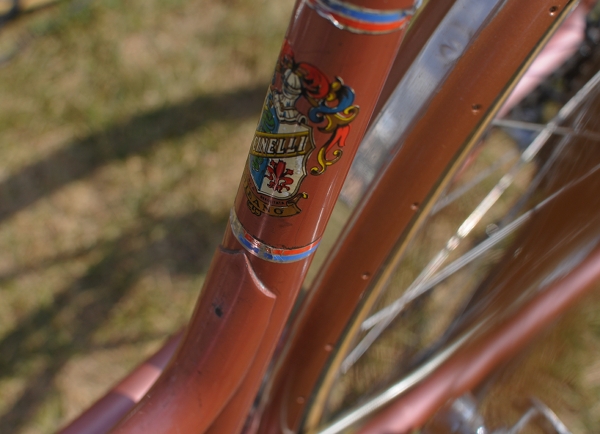 The colour is just the right mix of pink, beige and champagne to be feminine and glamorous, yet understated. The lines are curves are as graceful as can be.
The colour is just the right mix of pink, beige and champagne to be feminine and glamorous, yet understated. The lines are curves are as graceful as can be.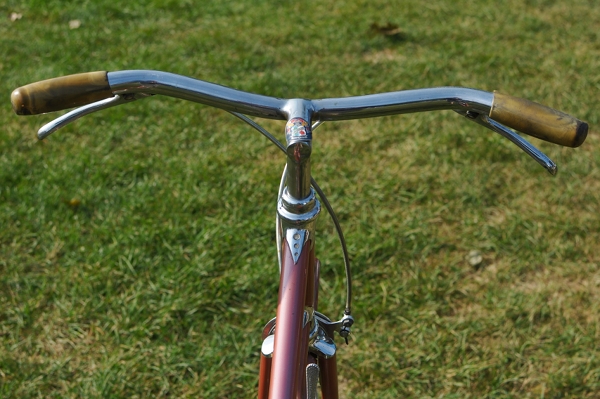 One piece handlebars and stem, with cream grips.
One piece handlebars and stem, with cream grips.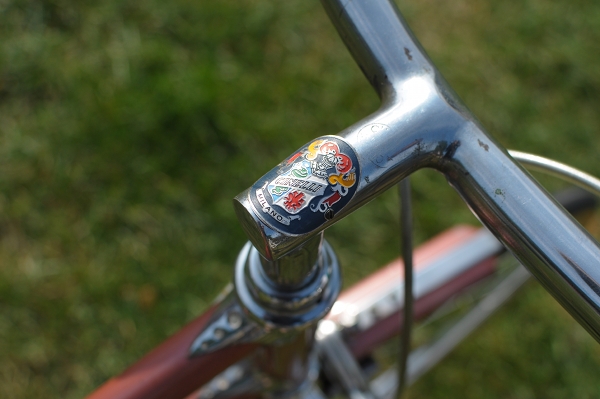 Cinelli crest on the stem! Just stunning.
Cinelli crest on the stem! Just stunning. There is a "his"model as well, and these bicycles were displayed as a pair. Riding these around town must have been a sight...
There is a "his"model as well, and these bicycles were displayed as a pair. Riding these around town must have been a sight... In addition to the exhibiting and selling of bicycles, there was a brisk trade in components, accessories, and vintage clothing. It was enough to make my head spin.
In addition to the exhibiting and selling of bicycles, there was a brisk trade in components, accessories, and vintage clothing. It was enough to make my head spin.